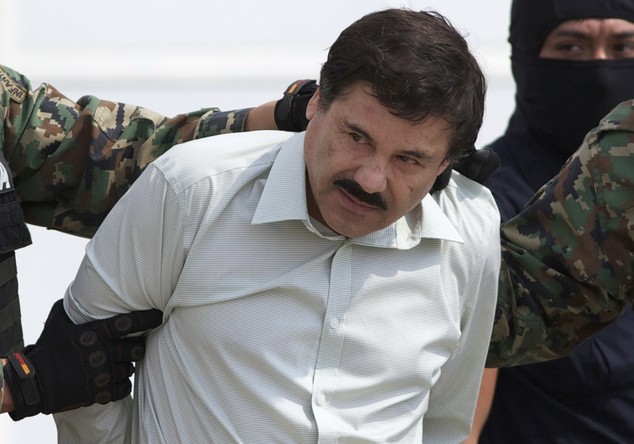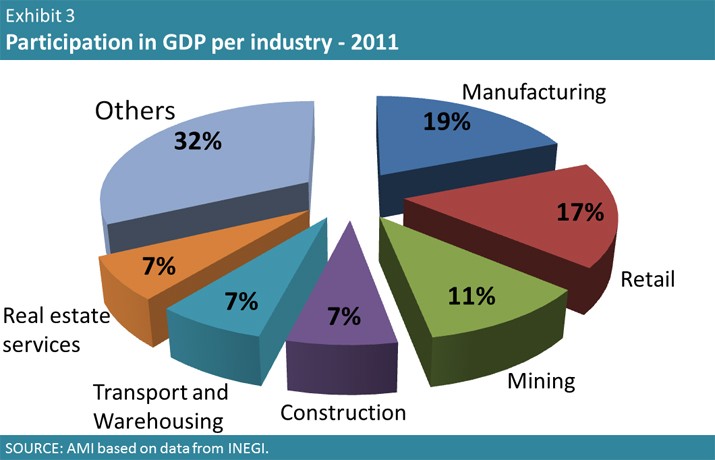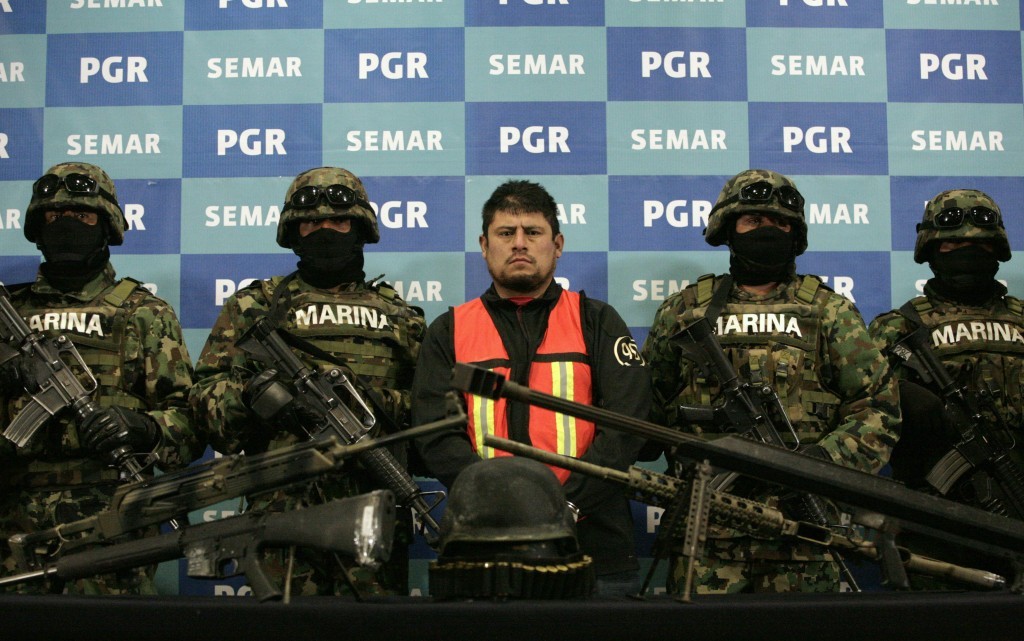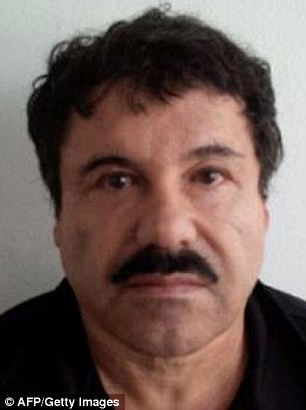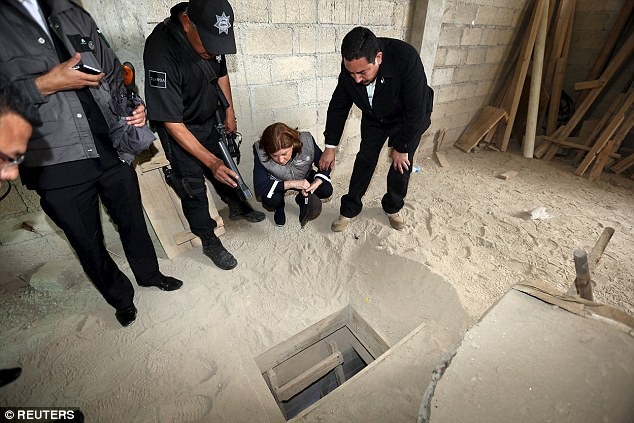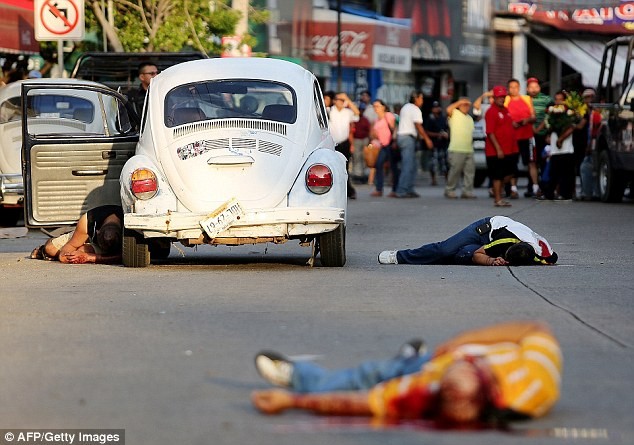I’m watching the news about “El Chapo” Guzman and wondering how long the lie will continue? What lie is that you ask? The lie about Mexico as being a real country. It’s not.
I have been to Mexico many times. I have worked in Mexico as well. I have had regular contact with various groups in Mexico both professionally and personally for going on 20 years. And will probably be going back to Mexico on and off for the foreseeable future. And many times, I am surrounded by as many assault rifles as Dos Equis.
If I said Iraq wasn’t a real country, most wouldn’t have a hard time accepting that.
If I said Afghanistan wasn’t a real country most would nod knowingly.
If I said Pakistan is an Army with a country attached to it, many members of the diplomatic corps would agree that description is more accurate than most understand.
If I say Mexico is not a real country, I get pilloried from both the left and the right for “unfairly characterizing all Mexicans.”
Well….is not a real country. It’s a “narco-state”. But not in the traditional sense. What in the hell am I talking about you ask?
Simple. Mexico on the international stage is a normal country. It has democracy. It has political parties. It has import and export policies. It has an economic policy. And it’s a member of NAFTA. If I wanted to move money from a US bank to a Mexican bank, I generally can. If I wanted to open a business in Mexico, I generally can. If I wanted to invest in Mexico, I generally can. And this applies not only to individual but to international businesses and financial institutions.
And that’s THE crux of the real problem. The drug lords and criminal enterprises that operate in Mexico NEED a country where their monies are easily fungible. In short, Mexico is a huge money-laundering operation. No. I am dead serious. A huge money laundering operation.
Take our boy “El Chapo” here. If you read this story, you will see references to industrial and commercial sized criminal enterprises: Construction companies. Fleets of 747 airplanes. Commercial canning and food operations. But it just doesn’t stop there. What makes Mexican drug lords so powerful is they use the Mexican state, economy and financial system to legitimize and launder their monies. Once that is done, the money can freely move around the world since it’s “legitimate” business investments. Not stack of $20’s and $100’s wrapped in large bales.
Drug lords can create logistics companies, construction firms, finance mining operations, finance high-end real estate developments, and even open and invest in shopping malls. Some of these business are created to help the drug trade function. Others are diversification and laundering of drug cash. While others are really done as forms of bribes and kickbacks. “Hello, Senior Politician. We have a business opportunity that we expect to be very valuable. OH? You don’t have enough cash on had to be a 20% equity investor? No problemo!”
Guys like Geraldo Rivera get all ass-hurt when anyone criticizes anything Mexican. Well…Mexico’s real problems aren’t illegals or even the smuggling across the border. Every border in the world has smuggeling operations. The real problems is Mexico are huge, structural problems. On the world stage, the Mexican government (local and federal) has more in common with Pakistan and Communist China just based on the corruption. If the Italian Mob was going to create a country to their benefit, they could create Mexico. If the FBI didn’t constantly crackdown and break large mob operations, we would be Mexico. If you look at large American cities with a known organized crime element, there are very many similarities to…wait for it…Mexico.
But it’s not all bad news. There are brave people in Mexico who individually stand up and fight. Many die. Most eventually are worn down or forced to look the other way…or else. The best example I can give is The Mexican Marine Corps. As an institution they are generally pretty trustworthy. They the ones most often credited with grabbing these powerful dopers.
Why? The Mexican Cartel problem is not a law enforcement problem. It’s too large. It’s too powerful. It’s a military problem. Ask any Mexican who the Cartels fear the most? Mexican Marines.
Marky
www.tacticaltshirts.com
“Shooting Guns & Having Fun”
A beauty queen wife, a $2.5m escape plot and a LOT of experience of tunnelling: The secrets of Mexican drugs kingpin El Chapo… and why the violent Public Enemy No1 may never be found
Joaquin ‘El Chapo’ Guzman fled from Altiplano prison on Saturday night
It is second time in 14 years that he has escaped from a high-security jail
Guzman burrowed his way out through tunnel, for which he is best known
Drug kingpin, who left school at eight, runs world’s most complex network of traffickers
As darkness fell over Mexico’s most secure prison on Saturday night, the country’s most powerful and enigmatic drug lord, Joaquin ‘El Chapo’ Guzman, executed an ingenious escape plot which has prompted one of the biggest manhunts in history.
In a scheme more befitting a caper movie, the cunning criminal mastermind crept into a small opening in his private shower in Altiplano prison, before fleeing through a one-mile tunnel, which officials believe had been covertly and audaciously burrowed for months on end.
It is the second time in 14 years that the drug kingpin – the head of the most powerful and ruthless drug trafficking organisation in the world – has embarrassed authorities through his expert escape, despite being described as the most wanted criminal since Osama bin Laden.
But his almost legendary escapes are perhaps unsurprising when one looks at Guzman’s lucrative and professionally-run life of crime, which has included brutal turf wars against other cartels, resulting in the death of tens of thousands of people.
Experts have now predicted that Guzman, who successfully crafted a Robin Hood image while rising to the top of the Sinaloa cartel, might never be found again.
Here, we look at how Guzman – who is married to a stunning former beauty queen – emerged at the helm of the most powerful drug squad in the world, before plotting two elaborate escapes and evading capture for decades.
The prison break
Guzman’s audacious escape, carried out just before 9pm on Saturday night, was discovered after the drugs baron failed to come out from the shower cubicle in his cell. When guards grew suspicious, they checked the washroom – and found a 10-metre deep hole containing a ladder.
But it was what was at the end of ladder which sent prison officials into a frenzy. Buried below was a vast, impressive tunnel, complete with a ventilation and light system which had all the hallmarks of a professional engineering job.
The tunnel – which experts believed was not made by Guzman himself – was reportedly dug with the help of a motorcycle which was mounted on a rail. It transported tools and earth in and out of the ground – something which might also have ferried Guzman to his freedom.
The sophisticated walkway then led to a grey brick building on a hill one mile away, surrounded by pastures in central Mexico State – from where he is believed to have collected clothes left for him by his conspirators.
Neighbours told today how the building had been bought six months ago by a man calling himself ‘El Pastor’ – the Shepherd – who brought wood and construction items to and from the site, claiming he was building a new house. But neighbours never saw any material change on the building.
Current building work taking place around the perimeter Altiplano prison is said to be connected to a water reservoir project, aiming to bring water from the west of the capital into Mexico City.
The company, Cutzamala Constructions, reportedly started the job around 14 months ago. But some of the pipes have still not been laid and workers admitted they did not know why the work was taking place in that area.
After Guzman’s escape was realised, police helicopters scrambled to track him down, as the local airport was dramatically closed. But the search – which is still ongoing – has not been successful.
Escape
It is not the first time that Guzman has escaped from under the nose of prison officials.
After being sentenced to 20 years in jail on drug-trafficking-related charges and murder, the fugitive made a legendary escape from the prison in Jalisco in 2001. Many accounts say he escaped in a laundry cart, although there are several versions of how he got away. What is clear is that he had help from prison guards, who were prosecuted and convicted following the incident.
It later emerged that the $2.5m escape was orchestrated through bribes and intimidation which involved up to 78 accomplices.
Capture
Guzman was first caught by authorities in Guatemala in 1993, before being extradited to Mexico when he was jailed for 20 years.
Despite his lengthy sentence, Guzman was said to have revelled in prison life, using bribes to bring in cocaine, Viagra – of which he is said to be a frequent user – prostitutes and gourmet food. Some claimed that he turned the prison into a ‘five-star hotel’.
Then, after his escape, it was another 13 years before Guzman was recaptured again. He was finally held in February last year, after a dramatic manhunt in which he eluded authorities for days across his home state of Sinaloa.
Before they reached him, security forces went on a several-day chase through Culiacan, the state’s capital. They found houses where Guzman supposedly had been staying with steel-enforced doors and the same kind of lighted, ventilated tunnels that allowed him to escape from a bathroom to an outside drainage ditch.
But he was finally tracked down to a modest beachside high-rise in the Pacific Coast resort city of Mazatlan, where he had been hiding with his wife and twin daughters.
Guzman has long been known for his ability to pay off local residents and authorities, who would tip him off to operations launched for his capture.
Tunnels
A bright and ingenious criminal, Guzman is perhaps best known for his network of elaborate tunnels which his cartel built underneath the Mexico-U.S. border to transport cocaine, methamphetamines and marijuana. As well as being a sure way to evade border officials for so many years, the tunnels became products of expert engineering, complete with ventilation, lighting and even railcars.
Guzman’s first tunnel came to fruition in the late 1980s, when he hired an architect to design an underground passageway from Mexico to the U.S.
Under the guise of a water faucet located outside the home of a member of the cartel in in Agua Prieta, the architect built a secret lever which activated a hydraulic system. That, in turn, opened a hidden trapdoor underneath a pool table inside the house, which led to a 200-feet passage.
After that tunnel was created, Guzman’s cartel acquired a reputation for the miraculous speed with which it could push the drugs across the border.
Although that tunnel was eventually discovered, gangs are still using Guzman’s method to ferry drugs illegally into the U.S. More than one hundred tunnels have been discovered for that purpose since Guzman’s first experiment 20 years ago.
Chilli peppers
As the head of a huge cartel constantly hunted by officials, Guzman had to reinvent his methods repeatedly. After his pivotal tunnel was discovered, he moved onto another speciality – chilli peppers.
Guzman opened up a cannera and began producing thousands of cans stamped ‘Comadre Jalapenos’. He then stuffed the peppers with cocaine, before vacuum-sealing them and shipping them to Mexican-owned shops in California.
Other trafficking methods included sending drugs in the fridge units of tractors trailers as well as in trucks filled with fish.
They used container ships, fishing vessels and submarines, all of which were floated downriver in separate pieces before being assembled at the coastline.
The cartel would also use its own fleet of 747s which they could load with as much as 13 tonnes of cocaine.
At one point, police erected an innovative, high-security fence along a stretch of the border in Arizona. But Guzman again found another way to evade the officials. While officers placed their confidence in the high-tech barrier, Guzman encouraged his traffickers to fling bales of cocaine over the fence – using a simple catapult.
School dropout
Guzman was born in April 1957 in the small, rural village of La Tuna, in the foothill of Sierra to a family of poor farmers. Although little is known about his upbringing, Guzman dropped out of school by the age of eight to work with his father, picking oranges. Together, they sometimes worked opium poppy fields.
Despite leaving school illiterate, Guzman showed that he was fiercely bright and, by the age of 15, he had started selling cocaine off his own back. His innate entrepreneurial streak meant he had soon earned enough to support his family.
In the 1980s, Guzman was recruited by Guadalajara cartel boss Miguel Angel Felix Gallardo, the ‘chief of chiefs’ and a godfather of Mexico’s modern drug cartels. Guzman’s job was to contact drug traffickers in the Colombian cities of Medellin and Barranquilla, gaining a valuable network of contacts to smuggle cocaine into the United States, Europe and Asia.
Entrepreneur
It wasn’t long before Guzman was working his way up through the ranks of his Guadalajara drug cartel. He had soon earned his place at the top of the cartel, presenting himself as an omnipotent criminal mastermind who never missed a trick.
When he was put on trial years later, one of his former associates described how Guzman was driven – bordering on obsessive – and was also a ruthless micromanager. However, he would often personally negotiate his own shipments to the U.S.
Billionaire
His ability to sneak tons of cocaine, heroin and marijuana into the U.S not only made him one of the country’s most wanted men, but also made him one of the most wealthy drug lords in history.
In 2009, Guzman made the Forbes list of billionaires. He was only left out of the list in 2013 because he was believed to have spent much of his wealth on protection and because his exact wealth could not be traced.
But he still remained on the Forbes list of the world’s most powerful people – and was even ranked above the French and Venezuelen presidents.
Family life
Guzman grew up with his family and had an acrimonious relationship with this father, who reportedly beat him and his siblings. He adores his mother, a staunch Catholic who is said to be the only person who has the ability to influence any of his decisions.
In August 2011, his stunning wife Emma Coronel – a former beauty queen – gave birth to a twins at a hospital on the outskirts of Los Angeles.
The couple married the day she turned 18 at a lavish wedding in the highlands of central Mexico in 2007, which was attended by police officials.
A California-born U.S citizen with no charges against her, she is the niece of drug lord Nacho Coronel, who died in a shootout with the Mexican Army in 2010. Before she gave birth, agents wanted to stop her, but had no formal charges to file so had to let her go free.
Birth certificates listed Coronel – believed to be the third or fourth wife of the fugitive – as the mother of the girls, but the spaces for the father’s name are blank. It means the children are also U.S citizens.
In 2008, his lover Zulema Hernandez was discovered dead in the trunk of a car her body carved with the letter Z’.
Public Enemy Number 1
Guzman was the first man to be named as ‘Public Enemy Number 1’, a moniker that had been given to US prohibition-era mafia boss Al Capone.
According to the Crime Commission in Chicago, Guzman ‘easily surpassed the carnage and social destruction that was caused by Capone.
After the death of Osama Bin Laden on May 2, 2011, Guzmán became the FBI and Interpol’s most wanted person.
Brutal
Guzman’s time at the top was marked by violence. His cartel became entangled in brutal turf wars against the likes of the paramilitary-like Zetas cartel, in violence which killed around 100,000 people.
At one time, during the most violent era, rivals’ wives were beheaded before being sent to their homes in cardboard boxes. Young children were also hurled off bridges. If any drug shipment was late, Guzman would personally shoot the smuggler in the head.
A gunfight in 1993 at the airport of Guadalajara that killed the western city’s archbishop, Cardinal Juan Jesus Posadas Ocampo, allegedly because he was mistaken for Guzman.
Guzman’s own family has paid for his life of crime. One of his brothers was killed in a Mexican jail in December 2004 and a son was killed in a Culiacan shopping centre in May 2008. His associates blamed the assassins of his former friend and business partner Arturo Beltran Leyva.
Even after his 2014 capture, Guzman’s empire continued to stretch throughout North America and reaches as far away as Europe and Australia.
Fatty and Shorty
Standing at just 5ft 6in, Guzman quickly inherited the nickname El Chapo – which means shorty.
He paired up with a Mexican trafficker Miguel Angel Martinez. The 25-year-old, who was a pilot, negotiated with cartels on behalf of Guzman and guiding their cocaine flights from South America to secret runways in Mexico.
Martinez became Guzman’s trusted right-hand man and would be offered tens of thousands in tips to set up a meeting with the drug lord. He also travelled around the world with him, took his phone calls and negotiated payments. Together, they earned the nicknames Fatty and Shorty.
When a lawyer asked whether he had been Guzman’s right-hand man, he replied that Guzman had five left hands and five right hands, adding: ‘He’s an octopus’
Despite the power he wields, Guzman has also lived a secretive existence and shuns the typical lifestyle of more flashy drug barons who often boast about their lavish lifestyle across social media.
For years, his location was part of Mexican folklore, with rumours circulating of him being everywhere from Guatemala to almost every corner of Mexico.
But he would occasionally turn up at a local restaurant with his entourage where his gunmen would ask every other diner to hand over their phones. They would then tuck into plates of fine food, before returning the phones to the punters and paying for everyone’s bill and leaving without fanfare.
- EP-390 -I Was Rightfully Wrong - January 3, 2026
- EP-389 – The Christmas Episode - December 23, 2025
- EP-388: FRT’s are Crushing The Machine Gun Market - December 5, 2025


